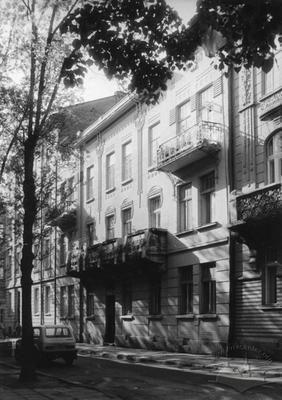Vul. Bohomoltsia, 08 – residential building
This three-storied residential townhouse was built in 1907 under a project designed at the architectural bureau of Ivan Levynskyi (Jan Lewiński) for the Elster and Topf company owned by Izrael and Salomon Elster as well as by Leon Topf. This is a residential building in Secession (Art Nouveau) style, and an architectural monument of local significance (protection number M-8). Now it is used mainly for dwelling purposes; the Maltese Aid Service in Lviv charity office is located in one of the apartments.
Architecture
The house is located in the row housing of Bohomoltsia street. This is a residential building whose planning is typical of the early 20th century townhouses. It is built with the use of modern materials and constructions and with the connection to the water supply, sanitation, and electricity networks. The townhouse is notable for its communications: the front staircase is semieliptical in plan and is lit by a skylight. The back stairs have side lighting and are located not typically, but just behind the front stairs. In the building’s decorative design some features of the geometric and ornamental Secession are combined.
The building has three stories and basements. It is built of brick and plastered. The basements are covered with Klein vaults; the bridgings between the floors are supported by metal I-beams; the attic floor is wooden. The stairs and balconies are made of reinforced concrete. The roof’s wooden structure of rafters and posts is covered with painted tin. Majolica tiles, moulded ornaments, panels with textured plaster surface, forged metal elements are used in the façades, entryway and staircase décor.
The building is U-shaped in plan. Typically, the entrance portal leads to a small entryway with a few steps. From there one can enter a spacious staircase, lit by a glass skylight in the roof. The stairs are semioval in plan; the back stairs are located behind them. According to the original project, there were three apartments on each floor: a four-room one and a six-room one, with kitchens, toilets, bathrooms, and utility premises located inside, and a two-room one situated in the wing and entered from the court or galleries (depending on the floor). The house’s courtyard is combined with the courtyards of the neighbouring townhouses number 11 and 9 on Hulaka-Artemovskoho street and number 7 on Klionovycha street; it is rather well lit and green.
The façade has six axes; its symmetry is broken due to the entrance portal location. Like the neighbouring building number 6, the façade’s general composition scheme is close to the Historicism: the three-part façade has a rusticated ground floor and symmetric protruded wall sections, crowned by attics, on both edges. All windows are rectangular and have no trimmings. The four central windows on the second floor have stylized Secession pediments in the form of moulded circles and a line of square moulded tiles with geometric patterns. On the second floor, there is a balcony, common to two apartments; it is supported by massive reinforced concrete elements serving as both consoles and railing elements. Above the third floor windows, there is a frieze. It is made of blue majolica tiles and continues with moulded décor of prominent horizontal bands on the protruded wall sections. The façade is crowned by a projecting cornice. The composition is made more vertical due to two Secession garlands with long moulded ribbons.
In some places the original window woodwork has been preserved: windows with two vertical casements and another one above at 1/3 of the window’s height, divided by vertical superimposed profiles. The skylight over the stairs has survived, as well as, though just partly, stained glass windows in the wall between the staircases made in the early 20th century at the workshop of Leon Appel.
Related Places
Vul. Bohomoltsia, 06 – Center for Urban History of East Central Europe building
Show full description
Vul. Bohomoltsia, 09 – Lviv Oblast Prosecutor Office (former residence)
Show full description
Personalities
-
Ivan Levynskyi
–
One of the most renowned architects of Habsburg Lviv, entrepreneur, one of the largest employers of his time in the city. His firm was involved in the construction and renovation of countless structures throughout Lviv and the region. Professor at the Higher Technical School, an active public figure associated with the Ukrainian People's Movement.
- Dawid Mazur – Photographer.
-
Oleh Luzhnytskyi
– Photographer.
Adam Kurtz— doctor, physician, resident of the house in 1937
Adolf Libman — a banker, resident of the house in 1910-1913
Adolf Reiss — an insurance company worker, resident of the house in 1913
Albert Fruchter — resident of the house in 1913
Andriy Zhuk (Andrzej
Żuk) — an editor, resident of the house in 1913
Anna Hadinger — a captain's widow, resident of the house in 1913
Bogumił Malawski — an intern at a custom's office, resident of the house
in 1913
V. P. Novoselov— resident of the house in 1946
Wanda Turkut — a widow, resident of the house in 1910
Władysław Kulczycki — an engineer, resident of the house in 1910
Henryk Fränkel — director of a company Schenker i Ska, which specialized in international transport services, resident of the house in 1937
Eugenia Zimels — a widow, resident of the house in 1913
Z. Dymitrowski — a physician, resident of the house in 1937
Zygmunt Regenstreif — an engineer, resident of the house in 1913
Ida Klein— the building's co-owner
Izydor Auerbach — a merchant, resident of the house in 1913-1932
Izrael Elster — co-owner of Elster&Topf
company
Joachim Pesches — a doctor, resident of the house in 1913
Kazimierz Wojnarowski —a jeweller, resident of the house in 1913
Klementyna Witosławska née Bochdan — owner of the
previous real estate
Lea Landau — a doctor, physician, resident of the house in 1932
Leon Topf — co-owner of Elster&Topf
company
Maurycy Scheftler — a merchant, resident of the house in 1913
Maksymilian Baumann — a bank officer, resident of the house in 1913
P. P. Chepurnoy — resident of the house in 1940
Sаlomon Elster — co-owner of Elster&Topf
company
Józef Grünfeld — an inspector of glass trade in Galicia and Bukowina, resident of the house in 1910
Józef Zaprułkiewicz — a bookman, resident of the house in 1914
Józef Majewski — an insurance inspector, resident of the house in 1913
Juliusz Silberbusch — a photographer,
co-owner of Foto-Oto photoatelier (1936-1938)
Jakób Verschleiser — the building's co-owner
Interview
Sources
- State Archive of Lviv Oblast (DALO) 2/1/128
- Informator lwowski, 1932.
- Ksiega adresowa krolewskiego stolecznego miasta Lwowa, 1914.
- Lewicki Jakub, Między tradycją a nowoczesnością: Architektura Lwowa lat 1893–1918 (Warsaw: Towarzystwo Opieki nad Zabytkami, Wydawnictwo Neriton, 2005), 260-261.
- Lwów. Ilustrowany przewodnik (Lwów: Centrum Europy; Wrocław: Via Nowa, 2001), 223.
- Skorowidz krolewskiego stolecznego miasta Lwowa (Lemberg, 1910).
- Skorowidz krolewskiego stolecznego miasta Lwowa (Lwow, 1920).
- Spis abonentow sieci telefonicznej..., 1937.
- Wykaz domów na obszarze miasta Lwowa, Księga adresowa Małopołski (Lwów, Stanisławów, Tarnopól, Rocznik 1935/1936), 2.
- Жук Ігор, Львівська пам’ятка стилю модерн. Ансамбль вулиці Богомольця та його архітектор,"Жовтень", 1983, №12, 83-85.
Media Archive Materials
Related Pictures




















